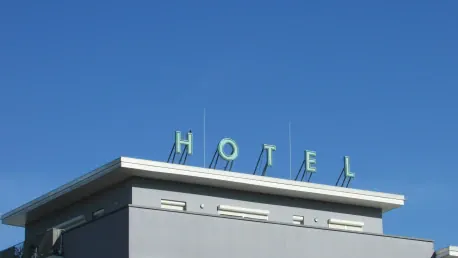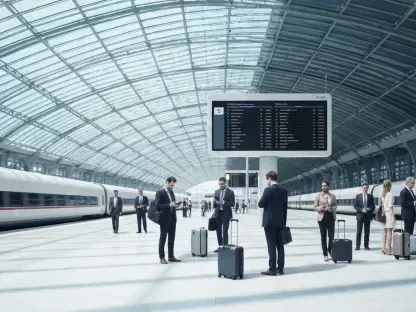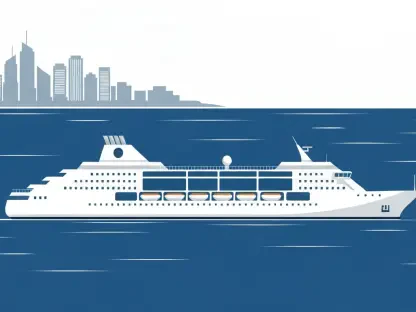The U.S. hotel industry is currently navigating a complex landscape, grappling with a multitude of challenges that are significantly impacting its outlook for the year. From shrinking demand and fewer international tourists to the escalation of operational costs, hoteliers are being called to employ innovative strategies to maintain stability and potential growth.
Market Dynamics and Consumer Confidence
Market Volatility
Jan Freitag, the national director of hospitality analytics at CoStar Group, brings attention to the U.S. hotel market’s volatile conditions. Despite an overall increase in hotel demand, detailed data reveals an underlying stagnation. Preliminary figures indicate a 1.4% rise in total U.S. hotel demand, but this perceived growth is skewed significantly by demand spikes in hurricane-affected regions like the Southeast and major city hubs such as Los Angeles. When these anomalies are removed from the equation, the demand growth across the remaining market drops to a mere 0.2%. This discrepancy highlights the ongoing instability and volatility in the market, which poses significant challenges for accurate forecasting and strategic planning.
Such volatility in the market complicates efforts to devise long-term strategies. Freitag suggests that the industry might have to grapple with these underlying issues, despite the seemingly positive surface-level figures. The nuanced demand landscape indicates that other regions without such demand boosts face flat or minimal growth, masking the true conditions faced by hoteliers nationwide. Mapping strategies to navigate these uneven growth patterns becomes a necessity, underscoring the importance of going beyond top-line figures to understand real market behaviors and trends.
Consumer Confidence
Compounding the issue of market volatility is the wavering consumer confidence, driven largely by prevailing economic uncertainties. Freitag highlights how these uncertainties are resulting in erratic booking patterns, further complicating the task of forecasting for the hotel industry. Consumers are increasingly cautious with their spending, especially on non-essential services like hotel stays, due to unpredictable economic conditions. This caution impacts booking behaviors, where shorter lead times and more frequent changes are becoming the norm, making it challenging for hoteliers to make accurate predictions and plan effectively.
The economic uncertainties are reshaping consumer behavior in significant ways, leading to a more reactive approach among travelers. Increased salvaging of budgets for essential expenses means discretionary spending like travel and lodging are subject to last-minute adjustments. This shift demands that the hotel industry not only adapts to real-time changes more efficiently but also implements flexible booking and cancellation policies to accommodate the volatile consumer confidence landscape.
Socio-Economic Factors and Consumer Behavior
Economic Disparities
One of the most glaring trends affecting the hotel industry is the significant performance disparities between high-end and budget hotels. Luxury segments are booming, primarily driven by financially resilient customers who are less impacted by economic fluctuations. These luxury travelers continue to drive demand, bolstered by their stable financial situations, and remain relatively unaffected by inflation. On the other hand, midscale and economy segments are struggling to keep up, with consumers in these categories feeling the economic pressures more acutely. This bifurcated market performance points to broader socio-economic disparities that influence spending behaviors and demand across different hotel categories.
The financial resilience of luxury segment customers provides a buffer that midscale and economy hotels lack. As inflation continues to rise, consumers with lower disposable incomes are cutting back on discretionary spending, including travel. This trend exacerbates the demand slump in budget and mid-tier hotel categories. The widening gap in performance between these segments illustrates the broader economic challenges impacting consumer behavior, highlighting the varying degrees of impact experienced across different market tiers.
Impact of Inflation
Inflation exerts a profound influence on the hotel industry’s dynamics, particularly affecting consumers in lower-tier market segments. As the cost of living climbs, these consumers face the strongest economic pressure, leading to reduced discretionary spending. Lower-tier market segments, therefore, experience subdued growth as their primary clientele tightens their budgets, directly impacting demand for hotel stays. A shift in spending priorities means consumers are more frugal, reserving their finances for essential needs rather than travel and leisure activities.
The broader economic landscape shows that the increased cost of goods and services leaves less room in personal budgets for non-essential activities such as hotel stays. This financial pressure is keenly felt across midscale and economy hotels, where the lower disposable income of their typical customer base contributes to lagging demand growth. As inflation persists, understanding its ripple effects on consumer travel behaviors becomes crucial for hoteliers aiming to strategize effectively, possibly focusing on value-added offerings to attract cautious spenders.
International Tourism Trends
Inbound Tourism Challenges
The challenge of attracting international tourists is another critical issue facing the U.S. hotel industry. While there has been a noticeable rise in Americans opting for international travel, affecting their domestic stay preferences, international inbound tourism to the U.S. has not mirrored this trend. Key contributing factors include the strong U.S. dollar, which makes travel to the U.S. more expensive for foreigners, and policies from the previous administration that have not been entirely reversed. These policies have created a less welcoming environment for international visitors, further dampening inbound tourism.
The strong U.S. dollar means that international tourists face increased costs when visiting the U.S., influencing their travel decisions. Additionally, policies that encompass restrictive visa regulations and stringent border controls from the previous administration continue to exert influence. These factors deter potential visitors, contributing to the overall decrease in international tourism. This decline poses a threat to the domestic hotel industry, which relies significantly on international visitors to sustain demand in numerous markets, particularly major metropolitan centers.
Political Influence
Adding to the complexities are the political influences that further discourage international travel to the United States. Political uncertainties and unfavorable immigration policies continue to serve as deterrents for potential international tourists. This scenario is aggravated by the prolonged impact of the policies from the previous administration, which continue to shape perceptions and influence travel decisions. Heightened political tensions and restrictive immigration stance have resulted in a less than favorable environment for attracting international visitors.
The impact of political uncertainty extends beyond policy changes, affecting travelers’ perceptions and comfort levels. As international tourists remain apprehensive about visiting the U.S. due to potential uncertainties, the hotel industry faces an uphill battle in revitalizing inbound tourism. This situation underscores the intricate interplay between politics and tourism, necessitating strategic initiatives by industry stakeholders to counteract these influences and attract international visitors in the future.
Rise of Short-Term Rentals
Alternative Accommodation Growth
The rise of short-term rentals represents another significant dynamic affecting the traditional hotel industry. Jamie Lane from AirDNA points out the resilience of short-term rentals, noting a substantial year-over-year increase in bookings on platforms like Airbnb and Vrbo. These short-term rental platforms are attracting a diverse set of travelers with their competitive pricing, unique accommodations, and personalized experiences. This popularity, particularly in urban areas and smaller cities, has resulted in a notable growth in short-term rental demand, which often outpaces hotel bookings in these regions.
The growing demand for short-term rentals highlights a shift in consumer preferences, where many travelers seek the distinct experiences and flexibility that these accommodations offer. Unlike traditional hotels, short-term rentals often provide more space, home-like amenities, and a sense of individuality, catering to travelers looking for alternatives to the conventional hotel experience. This trend underscores the need for traditional hoteliers to adapt and find ways to differentiate their offerings to compete with the appeal of short-term rental properties.
Market Adaptability
One of the key strengths of short-term rentals is their market adaptability. These platforms exhibit greater agility in adjusting to changing market demands compared to traditional hotels. The dynamic nature of the short-term rental market, coupled with significant annual turnover in listings, allows these accommodations to align more closely with consumer preferences. This flexibility in supply and demand adjustment is instrumental in maintaining their competitiveness, offering a viable alternative for various traveler segments.
The ability of short-term rentals to quickly adapt to market shifts serves as a significant advantage. They can dynamically adjust listings, pricing, and offerings to suit evolving travel patterns, catering to changing consumer needs more effectively. This agility is particularly advantageous during peak travel seasons or in response to emerging travel trends, enabling short-term rentals to capture demand more efficiently than traditional hotels. For the hotel industry, understanding and possibly incorporating such adaptable practices can be vital in enhancing their competitive edge and attracting a broader range of travelers.
Operational Challenges and Rising Expenses
Inflationary Pressures
Operational challenges, particularly those stemming from inflationary pressures, are a pressing concern for hoteliers. Robert Mandelbaum from CBRE Hotels Research explains that rising operational costs, especially those associated with labor, are increasingly nullifying the profit gains achieved during the post-COVID recovery phase. The increase in labor costs, coupled with overall inflation, means that hoteliers must revisit their profit-and-loss statements carefully. This careful approach includes a reassessment of operational efficiencies and potential adjustments to contain rising expenses while ensuring that service quality remains intact.
The surge in operational costs, wherein labor expenses play a major role, reverses the trend of leaner operations that were adopted during the pandemic recovery. As hotels face the reality of increased wages and higher prices for goods and services, the need to streamline operations without compromising quality becomes paramount. This scenario requires a rethink of cost management strategies, such as adopting technological solutions to enhance efficiency, exploring energy-saving measures, and revising procurement practices to offset inflationary impacts and safeguard profitability.
Labor Market Strain
The labor market strain, exacerbated by changing immigration policies and workforce dynamics, adds another layer of complexity to the operational challenges faced by the hotel industry. Labor costs have surged significantly as hotels strive to attract and retain workers amidst a competitive job market. Immigration policies restricting the inflow of workers who traditionally fill many roles in the hospitality sector exacerbate these challenges, compelling hotels to offer higher wages and better benefits to maintain a smooth operation.
At a time when the demand for service-oriented roles is high, immigration policy restrictions limit the availability of workers needed to fill these positions. Hotels are thus engaged in a continuous struggle to balance labor retention with operational expenses. Implementing measures such as competitive wages, conducive working environments, and comprehensive training programs becomes vital in navigating these labor market constraints. Managing workforce instabilities efficiently and ensuring a well-prepared team are essential for maintaining service quality and operational continuity within the competitive and evolving market landscape.
Navigating Future Prospects
The U.S. hotel industry finds itself navigating a challenging environment, contending with numerous hurdles that are influencing its outlook for the year ahead. A notable drop in demand, coupled with a decrease in international tourists, paints a worrying picture for many hoteliers. Compounding these issues is the rising cost of operations, which adds another layer of complexity to the mix. To navigate this turbulent landscape, hotel managers are compelled to devise and implement creative and innovative strategies aimed at maintaining stability and fostering potential growth. These strategies may include leveraging technology to enhance guest experiences, diversifying customer bases to mitigate risks associated with market fluctuations, and investing in green initiatives that can cut costs and appeal to eco-conscious travelers. The industry’s ability to adapt to these evolving challenges will likely determine its resilience and success moving forward. Therefore, adaptability and ingenuity are crucial for ensuring a sustainable future for U.S. hotels in these uncertain times.









